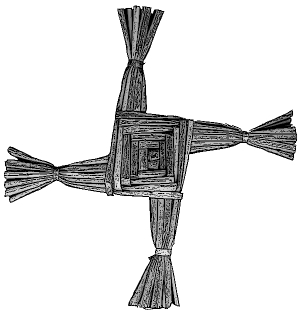Imbolg - The Celtic Feastday of Brigit - Celtic Goddess To Christian Saint

Pictured above is Brigit's Cross whose origins pre-date Christianity
Imbolg, also spelled Imbolc, is observed on the first day of February. It is the second of the four ancient yearly Celtic Festivals, representing the advent of the traditional agricultural year. Imbolg is a pastoral holiday marking the start of the lactation of domesticated sheep, an important annual milestone to the pastoral Celt. Imbolg is connected with the Celtic goddess Brigit because Imbolg is the same day as the Festival of the Goddess Brigit.
Christians recognize Brigit as an Irish Saint, second only to St. Patrick and ranking with St. Columba. But the pagan deity of the same name had a much wider influence in the pre-christian Celtic world.
In an article published by Transceltic on October 25, 2013 entitled Interview with Dr. Jenny Butler: The Celtic Folklore traditions of Halloween, we asked Dr. Butler to explain how the pagan feast day of Samhain (Halloween) become a holy day of the Catholic Church and if she saw a parallel in the merging of Imbolg, the Feast Day of the Celtic Goddess Brigit, into the Feast Day of the Catholic Saint Brigit. Dr Butler is a Folklorist and Lecturer at University College Cork's Folklore and Ethnology Department and a member of The Irish Society for the Academic Study of Religions. Dr. Butler has numerous articles to her credit and is currently working on a book about Irish contemporary Paganism. According to Dr. Butler:
"In relation to the Celtic Feast Day of Imbolg there is a clearer merging of pagan and Christian traditions. Brigit is a Christianised goddess who is associated with the spring festival. St Brigit’s feast day is February 1st and this is also the traditional marker of the beginning of spring. The Old Irish name for the festival is Oimelc, possibly meaning ‘ewe’s milk; lambs are born at this time of year and ewes come into milk at this point so that they will be able to feed the lambs during the coming season. The word imbolc or Imbolg, ‘im’ ‘bolg’, likely meaning ‘in the belly’, might also refer to lambing season. The Irish goddess Brigit is associated with human and animal lactation. She was said to be the daughter of the Dagda, one of the principle gods in the Celtic pantheon, and the wife of Bres, a half-Fomorii God. Although it is thought that people throughout Ireland venerated this goddess, she is particularly associated with the province of Leinster and she may have been the sovereignty goddess of that region. Her chief shrine was in Kildare, where priestesses tended her vigil fire. The shrine of Brigit was taken over by nuns and in legend these nuns continued to tend the sacred flame of Brigit at that same location in County Kildare until the thirteenth century, when the Bishop of Kildare decreed that the custom was pagan and therefore must cease. The goddess Brigit is a pan-Celtic deity and there are parallels in Britain with the worship of Brigantia, a name that means ‘high one’ or ‘queen’ and the name Brigit is thought by some scholars to be an epithet meaning ‘exalted one’. Another possible parallel is the Goddess Brigindo, worshipped by the Gauls. With the Christianisation of Ireland, the goddess Brigit became St Brigit and customs to do with the spring fertility festival were attached to St Brigit’s feast day in popular tradition. The correlation between Christian holy days and the earlier pagan religious festivals is even clearer in this case than in the case of Samhain."
- Emmett McIntyre's blog
- Log in to post comments






